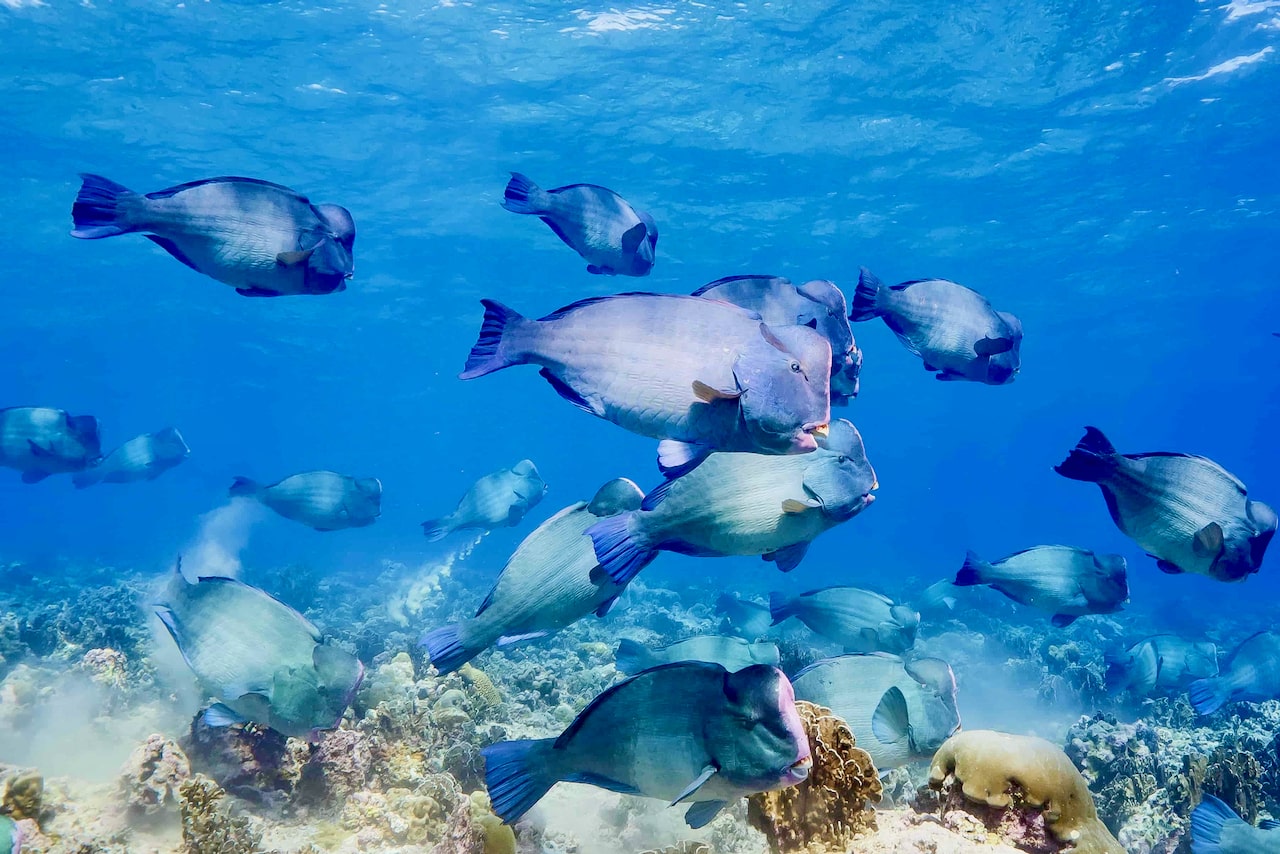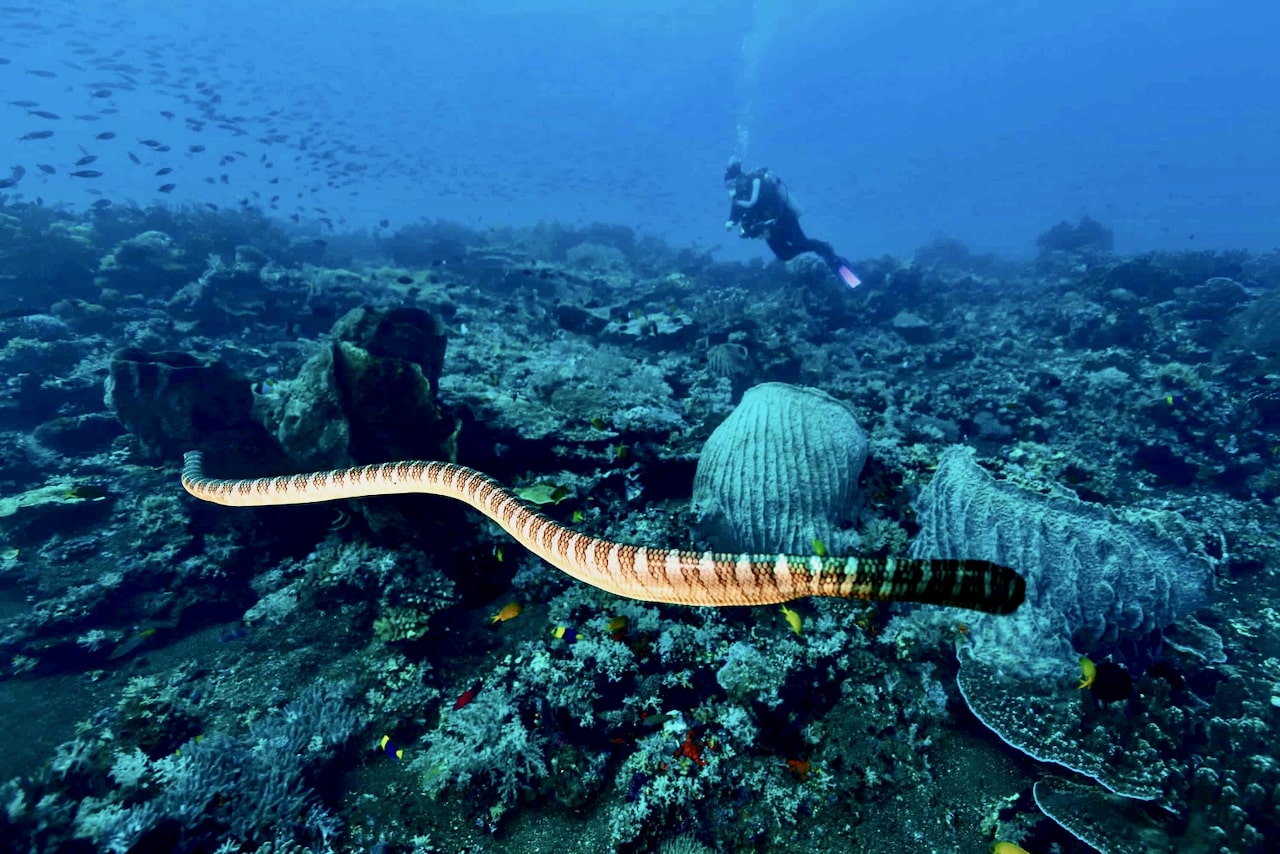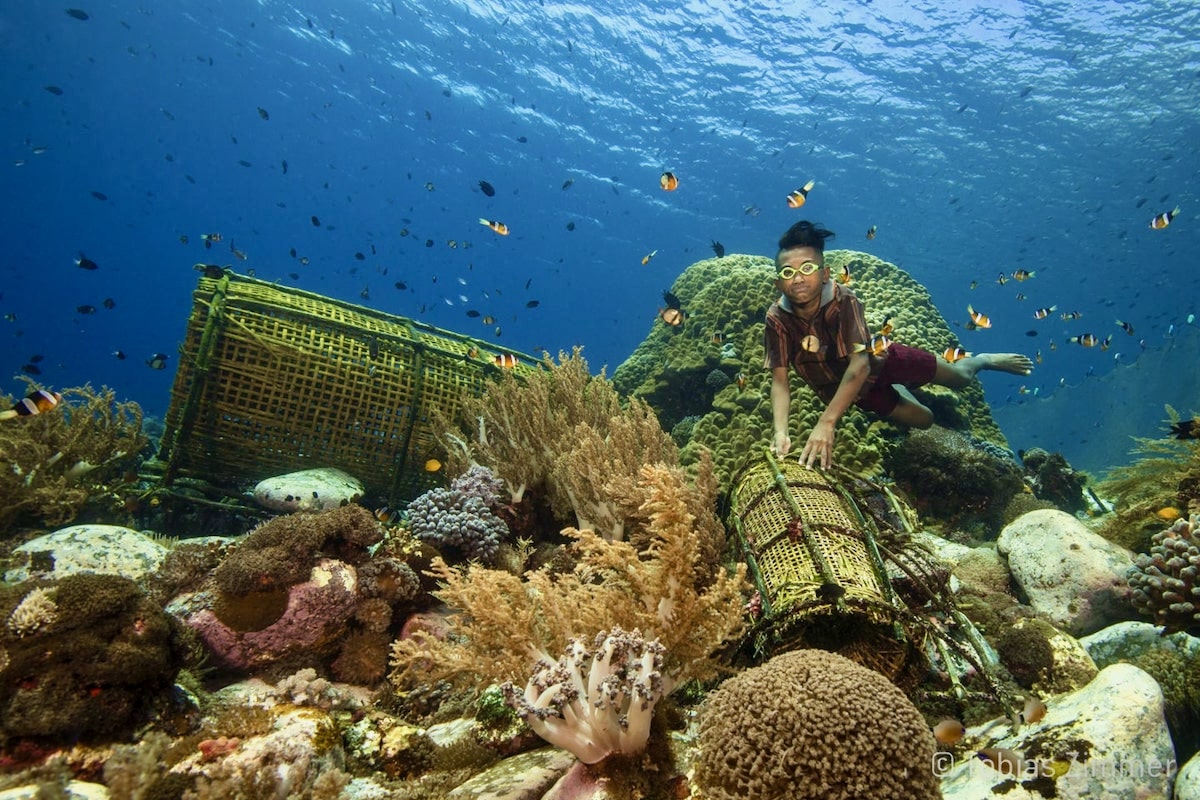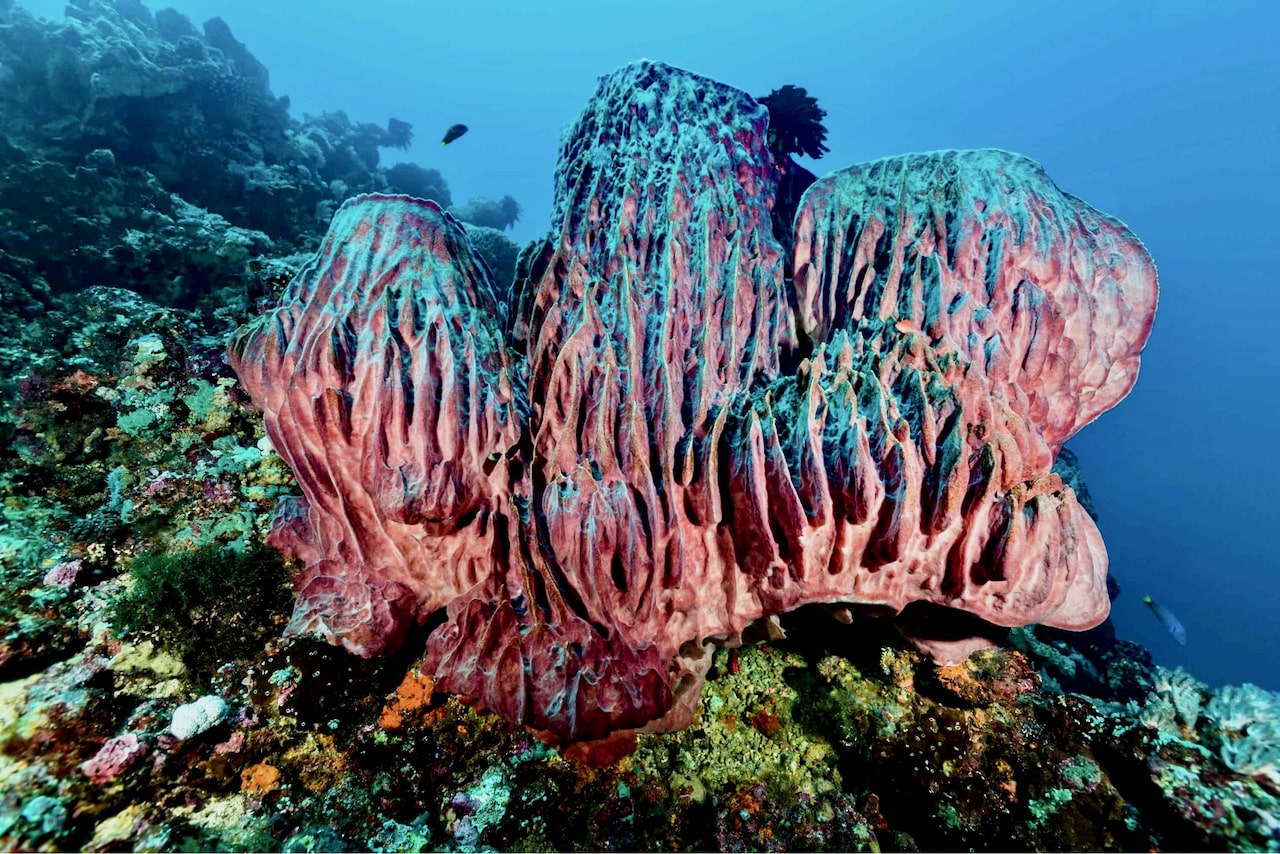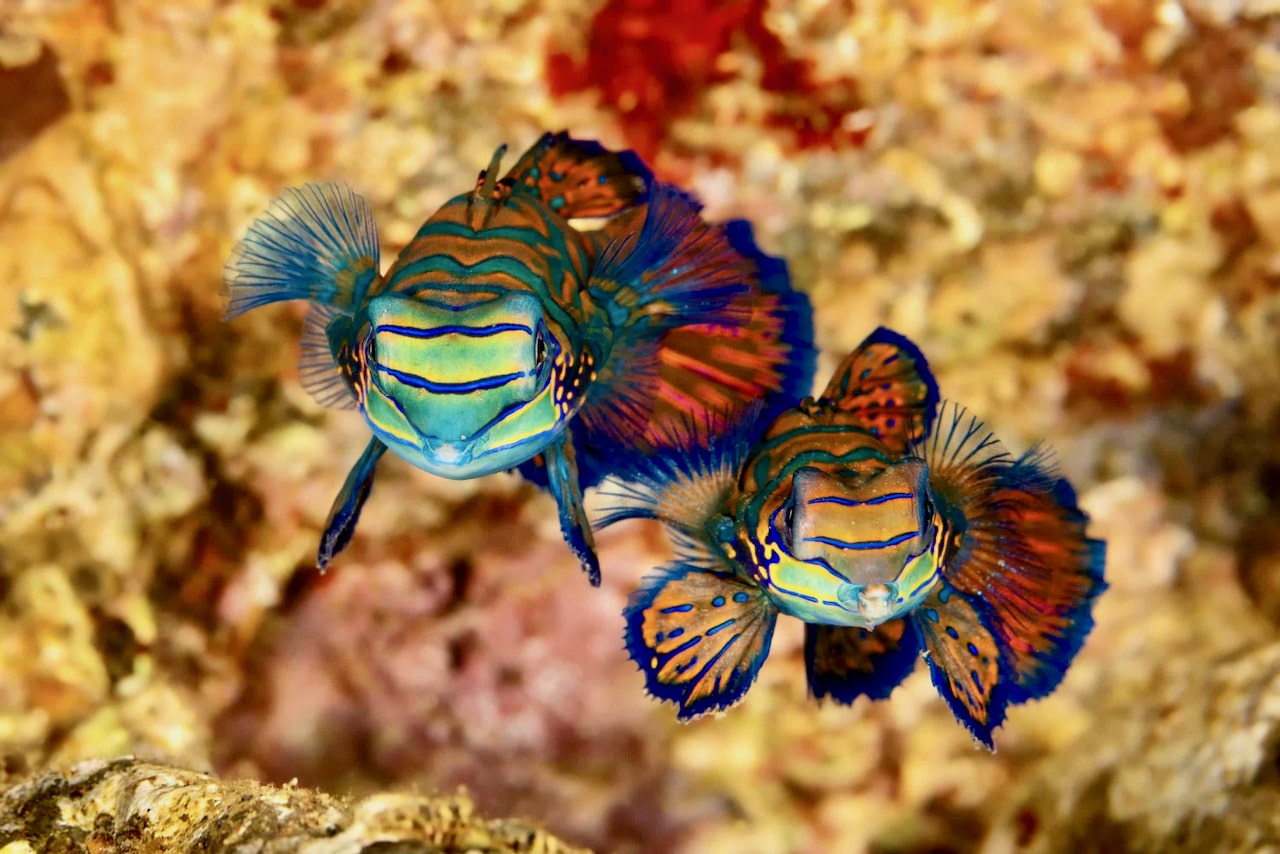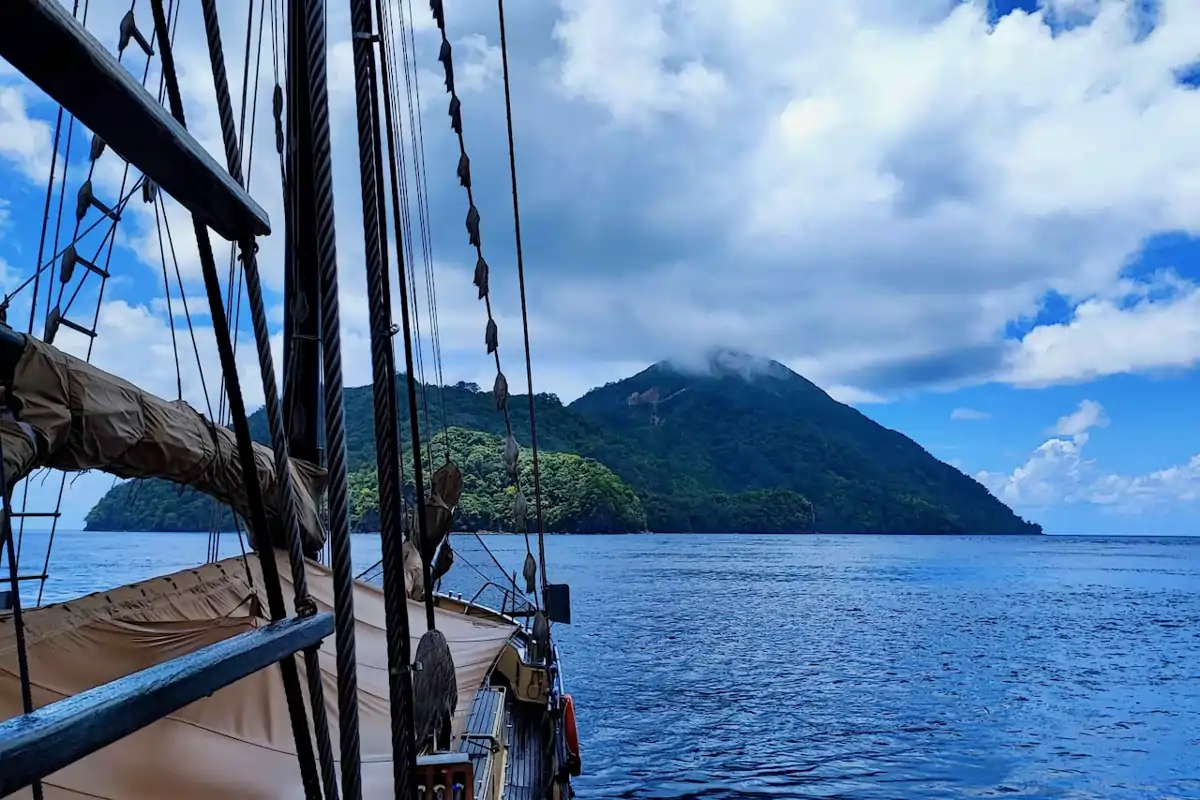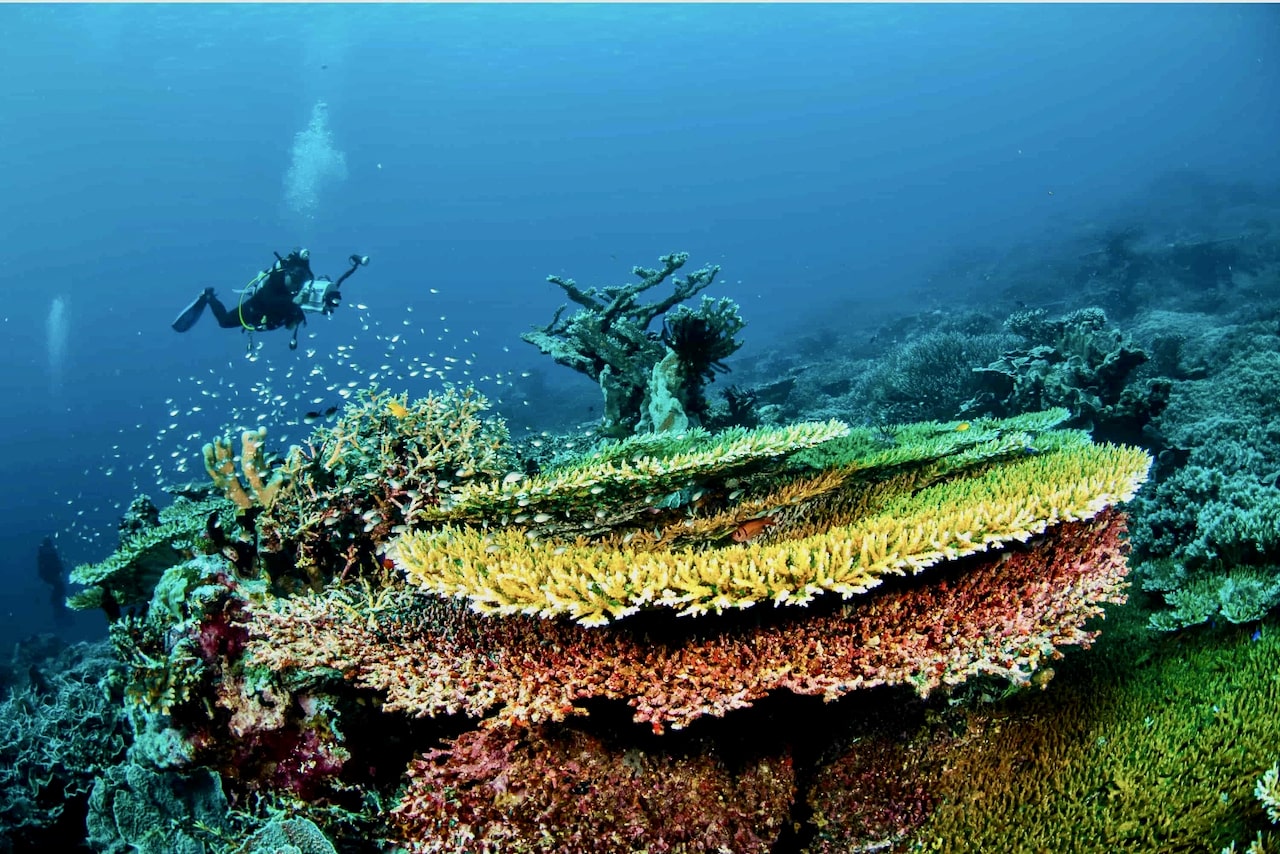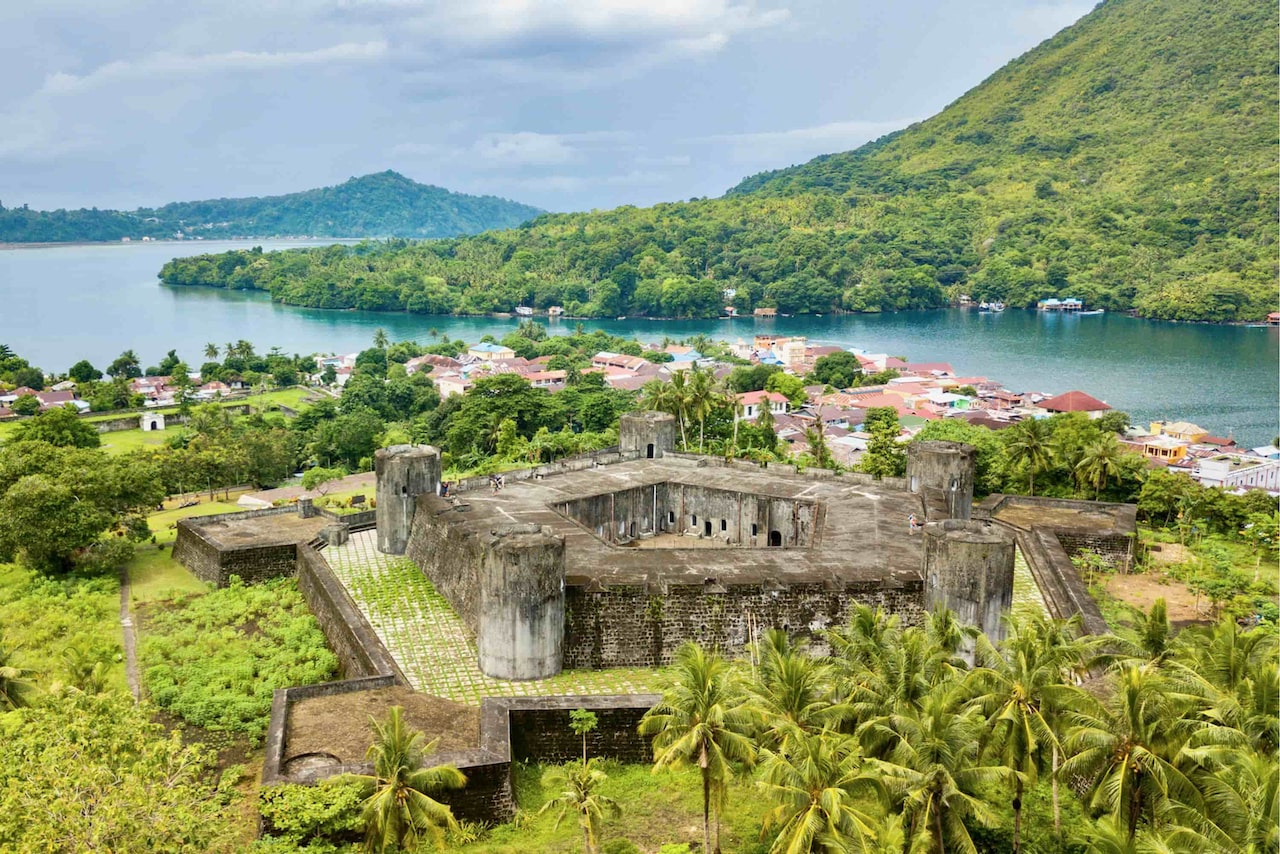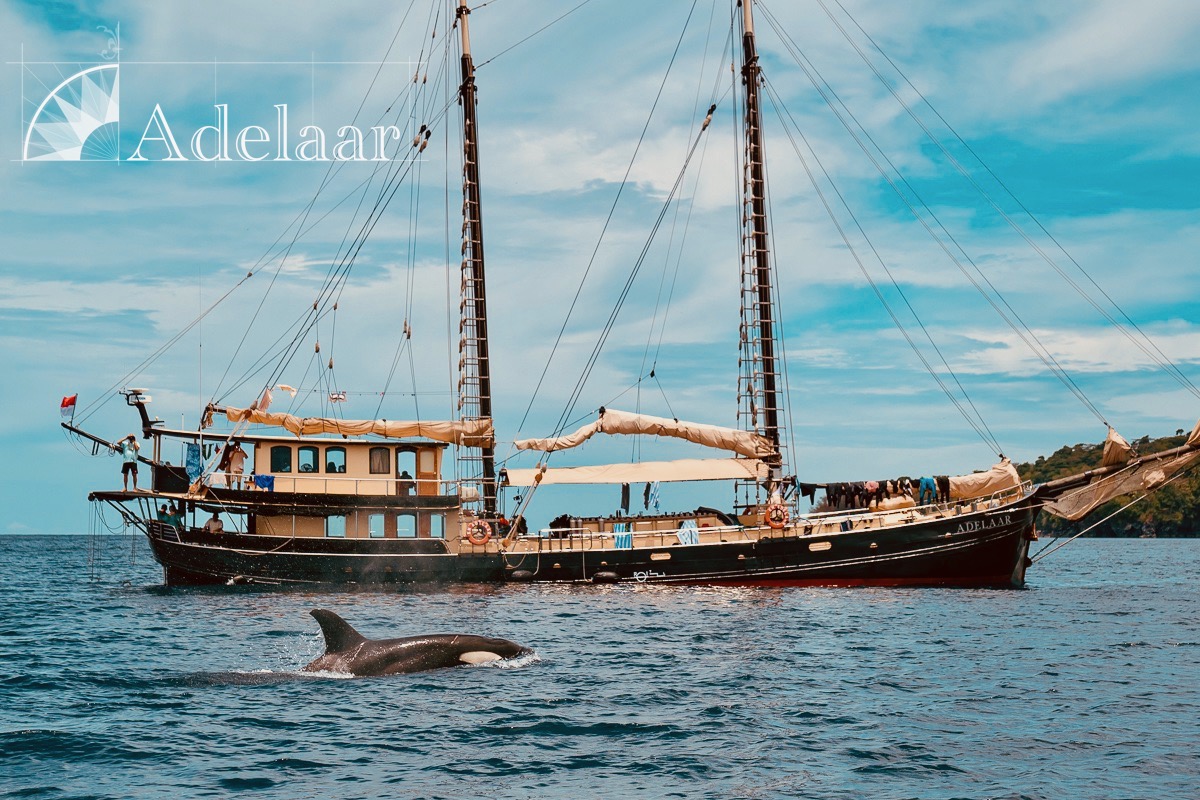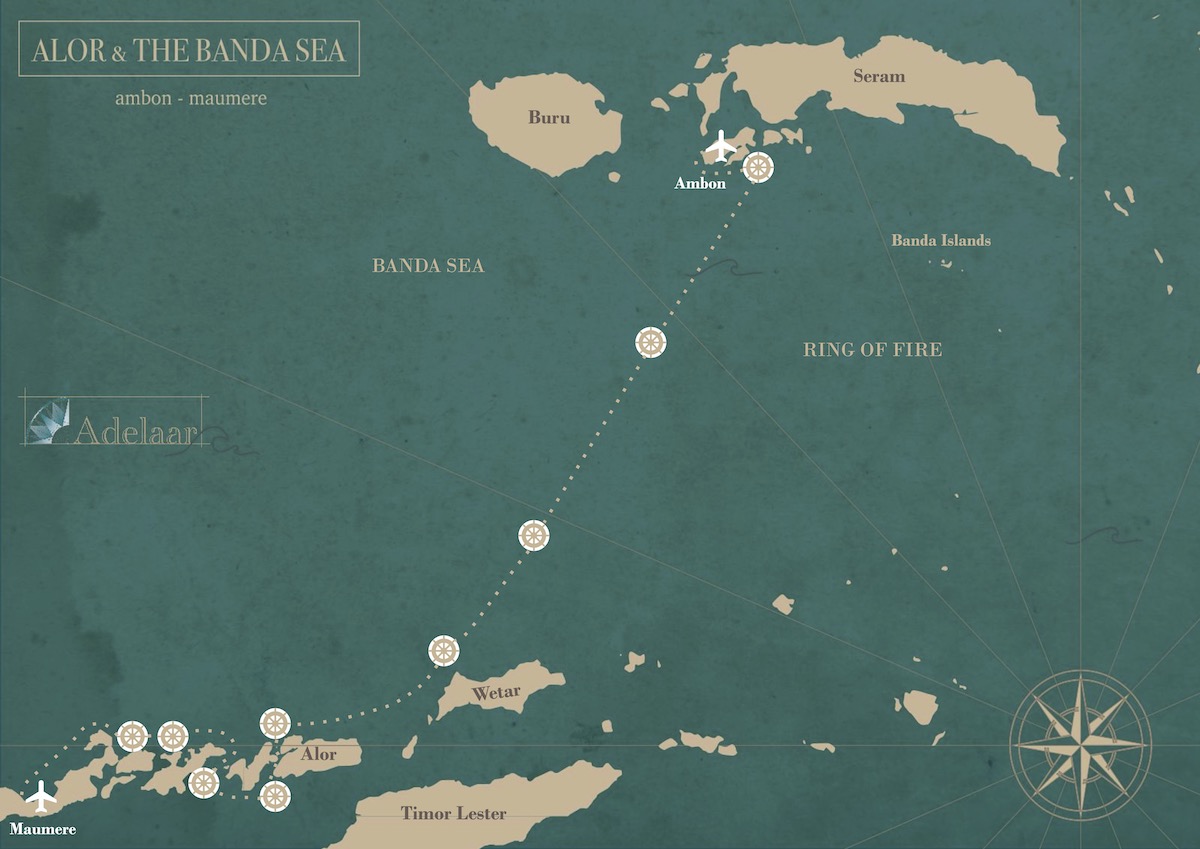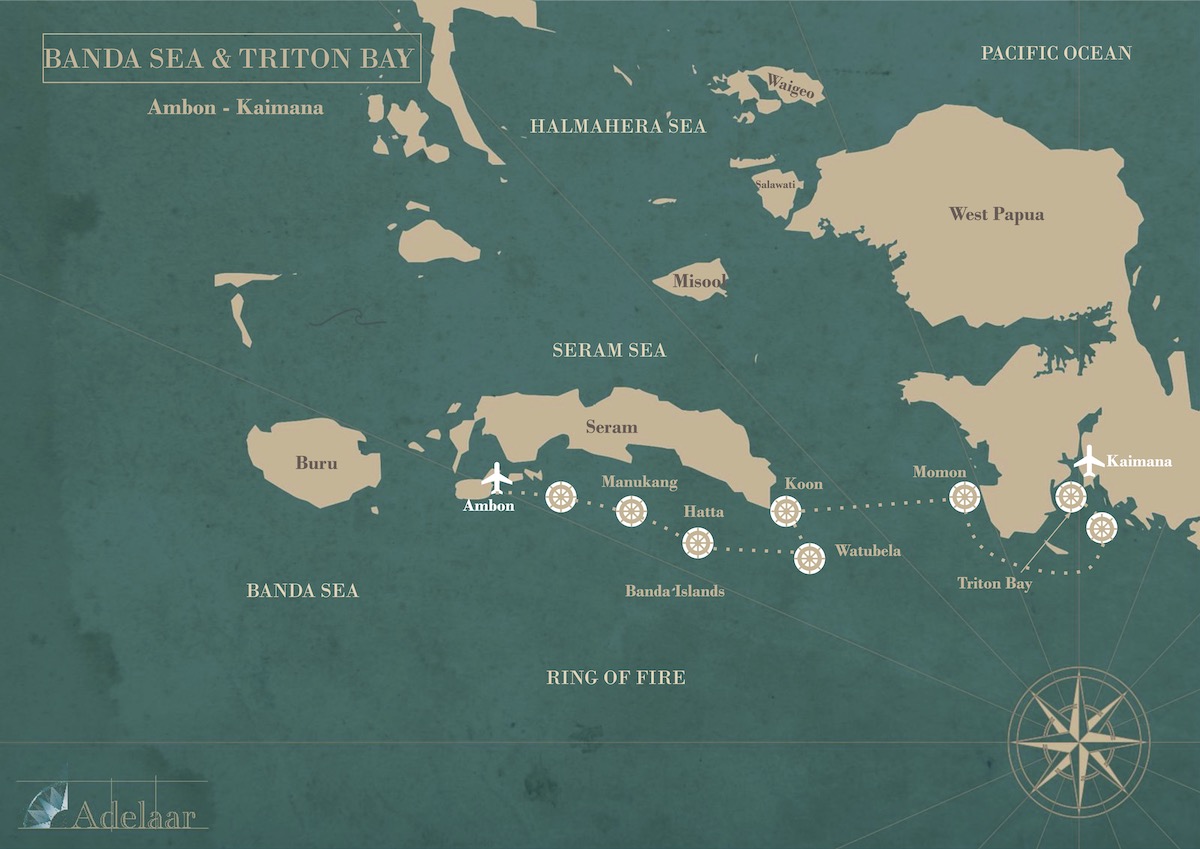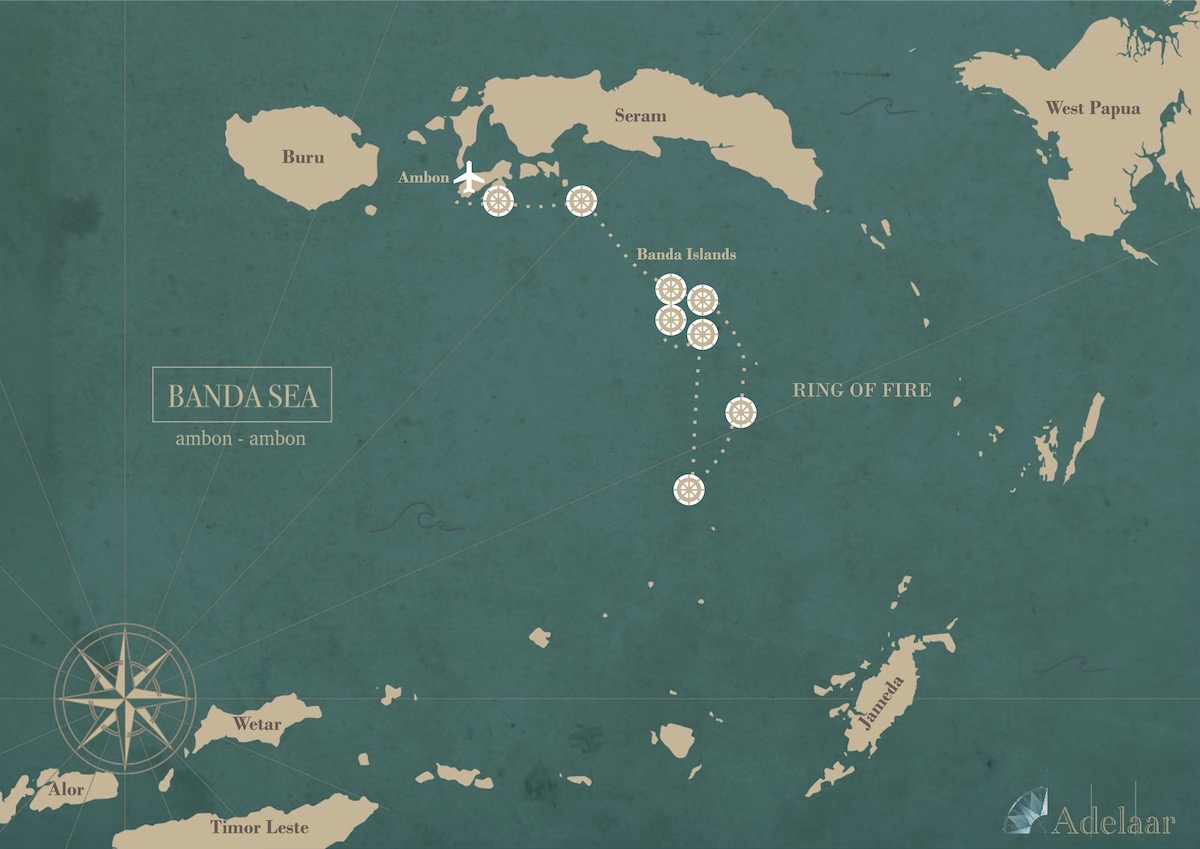Banda Sea Liveaboard with Adelaar: Dive With Hammerhead Sharks
Unveiling the Banda Sea: A Diver’s Sanctuary
Set off on an extraordinary journey with Adelaar, your luxury liveaboard gateway to the Banda Sea’s untouched splendor. Known as the ‘Forgotten Paradise,’ this remote gem offers a dive into history and biodiversity, surrounded by volcanic islands and an array of marine life. Explore vibrant coral gardens and rich historical sites in these pristine Indonesian waters.
Banda Sea Hammerhead Sharks Season
The Banda Sea’s unique location means it’s influenced by two main monsoon seasons. During the Northwest Monsoon (December to March), the region experiences the wet season with winds from the northwest, leading to increased rainfall. Conversely, the Southeast Monsoon (June to September) brings drier conditions with southeast winds. Consequently, the best times for diving in the Banda Sea are the intermonsoon periods (April to May and mid September to November). These transitional times offer calmer seas and clearer skies, making them ideal for exploring this marine paradise.
Encounter the Rich Marine Life
The Banda Sea’s dive sites are renowned for their unspoiled beauty and biodiversity. Encounter everything from majestic pelagic fish to schools of hammerhead sharks. Historical dive sites add a unique dimension, allowing you to explore relics from the past. Highlights include Gunung Api, known for its active underwater volcano, and the richly populated reefs around Ai and Hatta Islands. Each dive in the Banda Sea is a step into a vibrant underwater world, teeming with life and history.
Alor & The Banda Sea (Maumere – Ambon)
Day 1: Maumere
After boarding Adelaar in Maumere in the North of Flores, you will enjoy your first day on board whilst cruising eastwards along the Flores coast.
Day 2: Adonara
The submerged seamounts off Adonara are covered by a diverse mix of hard and soft corals. They provide shelter for a variety of reef fish and attract bigger predators such as jacks, tunas, and black tip and grey reef sharks. Juvenile silvertip sharks are often seen patrolling the typically clear blue water. (3 day dives)
Day 3: Pantar
We start the day with an adrenalin filled dive with the objective to see schooling hammerhead sharks, followed by a second morning dive on a stunning wall that is covered so completely in soft corals that we might get a sensory overload. The afternoon and night dive take place on a patch reef that is well known for harboring rhinopias. After the afternoon dive, we let the locals show us around their picturesque village. (3 day dives, 1 night dive)
Day 4: Pura
Today’s diving takes us on a unique site that is dominated by sheer endless carpets of anemones and regularly visited by thresher sharks and mola molas, a spectacularly beautiful hard coral reef, where one of the attractions is observing local freediving fishermen. The impressive big overhang hosts critters: clown frogfish, Pontoh’s pygmy seahorse or halimeda ghost pipefish can be found. Very likely Adelaar will be boarded in between dives by a group of local ikat weavers that offer their beautiful fabrics for purchase. (3 day dives)
Day 5: Wetar
After a night’s crossing we arrive in the morning in the Moluccas! Where we dive the walls and slopes of Reong and Wetar. Depending on the prevailing current they can be very rich in fish. Grey reef sharks, bamboo sharks, giant trevally, schooling big eyed jacks, rainbow runners and tunas are often seen here. On the quieter dives there are areas completely covered in zebra anemones. Looking closely, we may spot the beautiful but rare leopard shrimp that lives in symbiosis with them. We will set the sails as we start our journey into the heart of the Banda Sea. With a bit of luck, we may see some of the whales that migrate through these waters during this time of the year. (3 day dives)
Day 6: Gunung Api
Gunung Api simply means volcano in Indonesian. It is an old, lonely volcano that arises from the depth of the Banda Sea. It attracts a huge colony of resident seabirds above the waves, while under water the island is home to schools of jacks, surgeonfish, tunas, barracudas, and other pelagic fish species – as well as a lot of sea snakes. These venomous but unaggressive reptiles can be encountered on each dive around Gunung Api, sometimes in great numbers, which makes these dives absolutely unique. (4 day dives)
Day 7: Lucipara Maisel Archipelago
The Lucipara archipelago consists of several uninhabited low profile sandy islands with lush tropical vegetation. The islands themselves are inaccessible, protected by very shallow fringing reefs that extend several hundred meters from the shore line. At the edge these huge coral shallows plunge steeply into the typically crystal-clear abyss of the Banda Sea. Diving these remote locations has by definition an exploratory character – their location in the middle of the deep sea with no other islands around is very inviting for passing pelagics to hang around, thus increasing chances of close encounters between divers and bigger species such as tunas, rainbow runners, thresher sharks, silky sharks or hammerhead sharks. 4 day dives)
Day 8: Lucipara Penyu Archipelago
Another day just like the day before. Apart from the chances to see pelagics other strong points of these dives are the general healthiness and sheer vastness of the reefs. Some of the walls and steep slopes are studded with luxuriant soft coral growth, in other parts the landscape is dominated by huge barrel sponger or immense sea fans. The shallows are mainly intact hard coral gardens inhabited by myriads of different species of reef fish. (4 day dives)
Day 9: South Ambon
After two morning dives on the exposed south coast of Ambon Island that are both stunning from a topographical and coral cover point of view, we enter Ambon Bay where we will go hunting for critters. Thorny seahorses, ornate ghost pipefish, rhinopias, frogfish and ribbon eels are just a few examples to illustrate the extraordinarily rich muck diving of Ambon Bay. (3 day dives. 1 night dive)
Day 10: Laha
Laha’s muck diving sites are world renowned. Apart from a plethora of nudibranchs, cephalopods, ambon scorpionfish and different species of leaf scorpionfish, Laha is also famously the only place in the world where – with some luck! – the beautifully weird psychedelic frogfish may be spotted. (2 day dives)
Day 11: Ambon
After a last delicious breakfast, it is time to say goodbye and disembark – until the next time.
(Actual itinerary might vary depending on weather and sea conditions)
The Banda Sea & Triton Bay (Ambon – Kaimana)
Day 1: Ambon
After boarding Adelaar in Ambon, you will enjoy your first day on board whilst cruising straight into the heart of the blue Banda Sea.
Day 2 Manukang
Our first stop is Manukang, a volcanic outcrop that according to Moluccan lore, is known to be haunted. This we cannot judge, but what we do know, is that it attracts its fair share of pelagic visitors. Schooling hammerhead sharks swim along the underwater ridges that are covered in huge barrel sponges. 3-day dives
Day 3 Hatta
Hatta, the easternmost Island of the Banda archipelago, is named after Indonesia’s first vice-president who spent time here in exile. The diving off Hatta is dedicated solely to seeing schooling hammerhead sharks. The sight of groups ranging from a handful to literally hundreds of those majestic animals is an unforgettable experience, and one of the main reasons the diving in the Banda Sea is so special. 3-day dives
Day 4 Watubela
The Watubela archipelago is also regularly visited by schooling hammerhead sharks. However, this is not the only charm of these remote islands located at the border between the Banda and Seram Sea. Spectacular white sandy beaches offer perfect locations for those postcard sunset drinks after a day’s diving surrounded by schooling fish. 3-day dives
Day 5 Koon
Do you like diving with a lot of fish? In that case Koon is the place for you. Apart from having too many fish to list, there is also a spectacular land – or rather surface – activity nearby. Depending on the tide we can enter a hidden system of marine lakes and canals for a snorkel and swim trek unlike any other! Typically, at the end of the trail you will be greeted by enthusiastic local village children. 3-day dives
Day 6 Momon
The Momon Area of New Guinea is without a doubt one of the highlights for photographers. The very photogenic Kiti Kiti waterfall falls directly out of the vibrant jungle and into a turquoise sea. For those who are up for a land excursion, there are opportunities to venture into the forest a jungle trek. But first, there will be dives along the seamounts off the coast, known for their big schools of big eye trevallies, sharks, pelagic fish and oceanic manta rays. 3-day dives
Day 7 Aiduma
Along the coast of the karst island of Aiduma in the Aru Sea there are numerous little coves, islets and underwater formations with unique topography that are covered in dense soft coral growth. Fish life is profuse and features schools of snappers, sweetlips and fusiliers as well as napoleon wrasses, large groupers and wobbegong sharks. 3-Day Dives, 1 Night Dive
Day 8 Dramai
The eastern most point of our voyage is the island of Dramai. The waters surrounding this island are a sheer fish lover’s paradise. Reminiscent of rush hours in a big city, schools of different species of snappers, sweetlips, surgeonfish, batfish, fusiliers, jacks and other species make it so dense, it is difficult for divers to get a glimpse of the unique topography. The coral studded underwater formations include massive overhangs and swim throughs. With a bit of luck, we may even encounter oceanic manta rays. 3-Day Dives, 1 Night Dive
Day 9 Iris Strait
There is a regular through-flow of water in the Iris Strait between mainland New Guinea and Aiduma Island. This steady supply of nutrients triggers a veritable explosion of coral growth. Healthy areas dominated by enormous hard coral formations are interchanged with slopes covered in immense black coral bushes. The surrounding area is literally invaded by the largest and most colourful soft coral gardens that exist. All of this benthic life at- tracts schools of fish and squadrons of mobula rays. 3-Day Dives, 1-Night Dive
Day 10 Triton Bay
The diving in Triton Bay is unique, as the small islands act as fish magnets and feature exquisite coral growth of both hard and soft corals. The bay is home to a plethora of critters such as pygmy seahorses, leopard and tiger shrimps, endemic flasher wrasses or rare cephalopods. On night dives in this bay, be on the lookout for Triton Bay’s endemic walking shark. A structure resembling a huge underwater coral caldera is one of the topographic features of this area. Another topside highlight is our speedboat tour through the maze of the large Triton Bay lagoon with its countless hidden bays and channels surrounded by unique karst rock formations. 3-Day dives, 1-Night dive
Day 11 Namatote
If your trip happens to fall around a new moon, we will spend the day in the north of the island of Namatote. There we visit the traditional outrigger fishing platforms that are regularly visited by what the fishermen refer to as ‘mothers of fish’, i.e. the world’s largest fish, the majestic whale sharks. Closer to full moon there are no fishermen and whale shark sightings are rare. During such times we will concentrate on the dive sites south of Namatote with their pinnacles, caverns, swim-throughs, and black coral forests. On one special rock cliff only visible by boat we can see prehistoric rock art, evidence of the culture of the region’s earlier human inhabitants. After Namatote we start the final passage of the trip in style – by hoisting Adelaar’s set of sails! 2-Day dives
Day 12 Kaimana
After breakfast, it is time to say goodbye and disembark – until the next time.
(Actual itinerary might vary depending on weather and sea conditions)
The Banda Sea (Ambon – Ambon)
Day 1: Ambon
After boarding Adelaar in Ambon, you will enjoy your first day on board whilst cruising straight into the heart of the blue Banda Sea.
Day 2: Ai & Gunung Api
Our first day of diving is along the steep walls surrounding the whole island of Ai. From a plateau with pretty hard coral gardens, these walls, beautifully decorated in yellow soft corals, plunge deep into the dark blue clear Banda Sea. With a bit of luck we might already meet the first hammerhead shark of the trip. In the late afternoon everybody will be on deck to witness the goose bump moment of the arrival into one of the most spectacular and beautiful natural harbours in the world between the islands of Banda Neira, Gunung Api and Lonthor (Banda Besar). (3 day dives, 1 night dive)
Day 3: Banda Neira
After a guided visit to the historic town of Banda Neira, the fort, museum and spice plantations, we have traditional Bandanes breakfast before strolling back to port through the bustling market of this lovely town. One of today’s dives is on a new reef that has been growing naturally on the spur of the lava from Gunung Apis 1988 eruption – it is a fantastic example of nature’s ability to recover from natural disaster. In the evening we will dive at dusk to try and spot some romantic mandarin fish. (2 day dives, 1 dusk dive)
Day 4: Banda Besar & Sjahrir
On today’s menu is a spectacular submerged pinnacle covered in dense schools of fish and a couple of drift dives. The unique location of the Banda archipelago enhances chances of close encounters with pelagics such as big tunas, Spanish mackerels, giant jacks or even thresher sharks. In the evening we have a farewell dinner from Banda Neira in the tropical garden of a beautiful house from the colonial period. (3 day dives)
Day 5: Hatta
The diving off Hatta, the easternmost Island of the Banda archipelago, named after Indonesia’s first vice-president, is our first day of diving dedicated to seeing schooling hammerhead sharks.
The sight of groups ranging from a handful to literally hundreds of those majestic animals is an unforgettable experience – and one of the main reasons diving in the Banda Sea is so special. (4 day dives)
Day 6: Manuk
Manuk – “bird” in javanese – is an old, lonely volcano that arises from the depth of the Banda sea. It attracts a huge colony of resident seabirds above the waves, while under water the island is home to schools of jacks, surgeonfish, tunas, barracudas and other pelagic fish species – as well as a lot of sea snakes. These venomous but absolutely unaggressive reptiles can be encountered on each dive around Manuk, sometimes in great numbers, which makes these dives absolutely unique. (4 day dives)
Day 7: Sarua
There are no words that can do justice to the sheer awesomeness of the hammerhead site of Sarua. So we do not even try. (4 day dives)
Day 8: Sarua
As mentioned above. That’s why one day is not enough. (3 day dives)
Day 9: Run & Nailakka
Back in the Banda archipelago we dive around Run, an island that used to be the most desirable piece of real estate in the whole world. So desirable that it was reluctantly and under a lot of pressure traded by the English to the Dutch against an undesirable piece of land on the other side of the world called Manhattan. Apart from its history, Run is beautiful – on the surface covered in nutmeg trees and under the water the steep slopes are studded with huge gorgonian sea fans. It is yet another place that attracts schooling hammerhead sharks and other pelagics. We finish the day with a few drinks on the beach of Nailakka, the beautiful, but tiny island that was home to the English for several years after they lost Run to the Dutch. (3 day dives)
Day 10: Manukang
On the way between Run and Ambon we stop for a couple of dives on a volcanic outcrop that is according to Moluccan lore known to be haunted – this we cannot judge, but what we do know, is that it attracts its fair share of pelagic visitors that swim along its underwater ridges that are covered in huge barrel sponges. After the last dive we set sails and start our trip back to reality. (2 day dives)
Day 11: Ambon
After a last delicious breakfast it is time to say goodbye and disembark – until the next time.
(Actual itinerary might vary depending on weather and sea conditions)
Contact Us
Sign up for our newsletter





